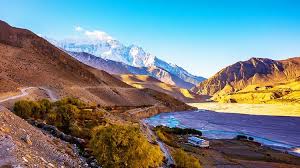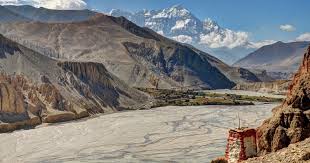Trip Facts
Duration
14 Days
Trip Grade
Moderate
Country
Nepal
Maximum Altitude
3,710 m
Group Size
1–12
Starts
Jomsom
Ends
Pokhara
Activities
Trekking
Best Time
Mar to May, Sept to Nov
Highlights
- Visit the sacred temple of Muktinath, a holy site for both Hindus and Buddhists.
- Scenic flight between Pokhara and Jomsom offering breathtaking Himalayan views.
- Explore Kagbeni, a traditional village with Tibetan influence and ancient monasteries.
- Walk through the world’s deepest gorge – the Kali Gandaki Valley.
- Stunning views of Dhaulagiri, Annapurna, Nilgiri, and Tukuche peaks.
- In Marpha, Nepal’s apple capital, you can visit apple farms and try fresh local foods.
- Explore a wide range of scenery, including lush valleys, dry deserts, and mountains capped with snow.
- Learn about the Thakali people and their customs, food, and way of life.
Overview
The Muktinath Jomsom Trek is a classic trip in the Himalayas that blends spirituality, natural beauty, and learning about other cultures in a beautiful way. It takes 14 days to go on this trek from Kathmandu, which is a busy city, to the Annapurna area, which is peaceful and high up. An important journey for many, it’s more than just a hike. Many Hindus and Buddhists visit Muktinath every year because it is one of the most important sites in Nepal. Trekkers can walk along the famous Kali Gandaki Valley on this path. The valley has dramatic cliffs, fossils from long ago, and stunning views of the Annapurna and Dhaulagiri ranges.
The Muktinath Jomsom trek is not as difficult as some other high-altitude treks. It’s good for families, first-timers, and people who want to experience culture along with their mountain journey. You’ll see interesting towns like Kagbeni and Marpha along the way. The Thakali people will be friendly, and you’ll see how life thrives in one of Nepal’s driest areas. This trek is a great way to see Nepal because it has the right amount of spiritual importance, beautiful mountain scenery, and cultural depth.
Itinerary
As soon as you arrive at Tribhuvan International Airport, your trip starts. Our staff will greet you and take you to your hotel. Today, you should mostly rest and get used to your new surroundings after your international trip. At night, we'll have a welcome meal with traditional Nepali food and talk about the trip that's coming up. Spend the night in Kathmandu. It comes with dinner.
We dedicate today to exploring the rich cultural heritage of the capital city. You will visit Pashupatinath, a holy Hindu temple by the Bagmati River, Swayambhunath (also known as the Monkey Temple), and Boudhanath, one of the largest Buddhist stupas in the world. These visits give a glimpse into Nepal’s deep spiritual traditions. Later, you’ll meet your trekking guide for final preparations. Overnight in Kathmandu. Dinner included.
We leave Kathmandu by tourist bus or private vehicle and follow the scenic Prithvi Highway. The drive passes rivers, terraced fields, and small towns with views of the Himalayan peaks in the distance. Upon arrival in Pokhara, we check into the hotel and relax near Phewa Lake, a popular spot for boating and enjoying sunset views. Overnight in Pokhara. Dinner included.
We fly to Jomsom early in the morning. This brief flight is well-known for its up-close views of Dhaulagiri and Annapurna. Jomsom is the entry point to Upper Mustang and is renowned for its powerful winds. To get to Kagbeni, a medieval village with stone homes, prayer wheels, and a monastery, we hike for roughly three to four hours along the Kali Gandaki River. Spend the night at Kagbeni. Included is dinner.
The hike today takes roughly five to six hours. We ascend slowly through tiny communities and arid, desert-like terrain. As we gain altitude, the sacred temple of Muktinath comes into view. It is revered by both Hindus and Buddhists, featuring an eternal flame and 108 stone water spouts. Pilgrims from all over South Asia visit here. Overnight in Muktinath. Dinner included.
In the morning, we visit the Muktinath temple complex and take time to observe pilgrims performing rituals. Later, we descend along a different trail, passing through Jharkot and Kagbeni before continuing to Marpha. Marpha is known for apple orchards, whitewashed houses, and a tranquil setting. Overnight in Marpha. Dinner included.
Walking for 6–7 hours, we follow the Kali Gandaki Valley. The landscapes begin to change as we leave the dry Mustang region and move into greener areas. Ghasa is a small settlement often known for bird-watching opportunities. Overnight in Ghasa. Dinner included.
Today’s trail leads us down to Tatopani, a village named after its natural hot springs. This is a highlight for many trekkers, as you can soak in the warm pools after a long day’s trek. The walk takes about 6 hours through terraced fields and suspension bridges. Overnight in Tatopani. Dinner included.
We start a steady climb of about 7 hours, passing villages like Shikha and Chitre. The route takes us through rhododendron forests, which are especially beautiful in spring. Ghorepani is a popular stop for trekkers heading to Poon Hill. Overnight in Ghorepani. Dinner included.
We wake up before dawn for a 45-minute hike to Poon Hill, one of the best viewpoints in the Annapurna region. The sunrise over Annapurna, Dhaulagiri, and Machhapuchhre is breathtaking. Afterward, we return to Ghorepani for breakfast and continue trekking through forests to Tadapani, a small village surrounded by oak and rhododendron trees. Overnight in Tadapani. Dinner included.
A shorter trek today takes about 4 hours. We descend through forests to Ghandruk, one of the largest Gurung villages in Nepal. The village is known for its cultural museum and traditional stone houses. We can also enjoy close views of Annapurna South and Machhapuchhre. Overnight in Ghandruk. Dinner included.
We travel downward to Nayapul, crossing terraced farmlands and towns, to finish our hike, which takes four to five hours. We drive back to Pokhara from Nayapul, where you may unwind by the lake and take in the lively ambiance of the town. Spend the night at Pokhara. Included is dinner.
We travel back to Kathmandu by tourist bus or private vehicle, enjoying the scenic ride. Upon arrival, you’ll have some free time for last-minute shopping before a farewell dinner with cultural performance. Overnight in Kathmandu. Dinner included.
Our representative will transfer you to the airport for your international flight. Breakfast included.
Cost Details
Included
- Airport pick-up and drop-off by private vehicle
- 3-star accommodation in Kathmandu and Pokhara with breakfast
- Tea house accommodation during the trek
- All meals during the trek (breakfast, lunch, dinner)
- Licensed and experienced English-speaking trekking guide
- Porter service (1 porter for every 2 trekkers)
- Domestic flight from Pokhara to Jomsom
- All ground transportation as per itinerary
- Annapurna Conservation Area Permit (ACAP)
- Trekkers’ Information Management System (TIMS) card
- First aid kit carried by the guide
- Welcome and farewell dinners in Kathmandu
Excluded
- International flights to and from Nepal
- Nepal visa fee
- Travel and medical insurance
- Personal trekking gear and equipment
- Extra accommodation and meals in Kathmandu and Pokhara beyond the itinerary
- Tips for guide and porter
- Snacks, drinks, and bottled water during the trek
- Costs arising due to unforeseen events like weather, flight delays, or political strikes
Useful Information
- Trekking Difficulty: This trek is moderate. Expect daily walks of 5–7 hours. The terrain varies from flat riverbeds to uphill climbs.
- Best Seasons: Spring (March–May) brings blooming rhododendrons and clear skies, while autumn (September–November) offers stable weather and excellent visibility. Winter and monsoon are possible but come with challenges such as cold or heavy rain.
- Accommodation: You will stay in tea houses, which are simple but comfortable. Expect twin-sharing rooms with shared bathrooms. In Kathmandu and Pokhara, you’ll enjoy hotels with modern facilities.
- Altitude Sickness: The highest point of this trek is Muktinath at 3,800m, which is relatively safe, but everyone reacts differently to altitude. Walk slowly, drink plenty of water, and follow your guide’s advice.
- Food: Tea houses offer Nepali meals like dal bhat, noodles, soups, bread, and vegetables. In Marpha, don’t miss trying apple pie, dried apples, or local apple cider.
- Culture: This region is home to the Thakali people, known for their hospitality and cuisine. Respect local customs by asking before taking photos and dressing modestly near religious sites.
- Packing: Pack layers of clothing for both warm days and cold nights. A sleeping bag, trekking boots, windproof jacket, sunscreen, and personal medications are essential.
- Electricity & Internet: Tea houses provide electricity to charge devices for a small fee. Internet (Wi-Fi) is available in most villages but can be slow.
- Money: Carry cash in Nepali rupees for personal expenses, as ATMs are not available in the trekking villages.
- Transportation Notes: Flights to Jomsom are weather-dependent. If canceled, the trek will be adjusted with road transport.
FAQs
The trek is moderate in difficulty, suitable for first-time trekkers and families. Daily walks range from 5–7 hours.
The highest point is Muktinath at 3,800m.
No, although a basic level of fitness is necessary, this walk is suitable for beginners.
Both a TIMS card and an Annapurna Conservation Area Permit (ACAP), which are included in the package, are required.
Yes, Muktinath is open to everyone. Visitors come for spiritual, cultural, and scenic experiences.
Yes, at Tatopani you can enjoy natural hot springs, a highlight of the journey.
Tea houses and lodges along the trail provide basic but comfortable lodging.
Yes, but it can be very cold and flights to Jomsom may be affected by weather.
Yes, you can combine it with the Upper Mustang trek or Ghorepani Poon Hill trek.
It blends cultural exploration, spiritual significance, and natural beauty in one journey—something few treks can offer.



